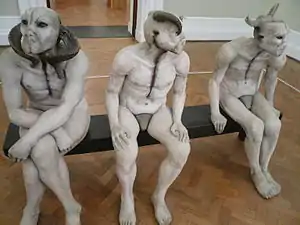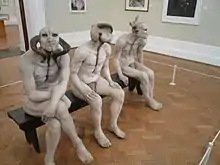The Butcher Boys
Butcher Boys (1985/86) is a sculpture made by South African artist Jane Alexander of three life size, oil painted plaster figures with animal horn and bone details, seated on a bench. The work formed part of her MAFA submission (University of the Witwatersrand) and was first exhibited at the Market Theatre Gallery in Johannesburg in 1986. It was acquired by the South African National Gallery in 1991. The work was a response to the state of emergency in South Africa at the time.[1]
| The Butcher Boys | |
|---|---|
 Butcher Boys, National Gallery of Arts, Cape Town, South Africa. | |
| Artist | Jane Alexander |
| Year | 1986 |
| Medium | mixed media |
| Location | South African National Gallery, Cape Town, South Africa |
| Accession | no. 90/73 |

"...Jane Alexander arrived at the humanimal during a crisis period of uncertainty and transition in South Africa - the state of emergency declared in 1985, when she created Butcher Boys as part of her graduate studies, was renewed each year up to 1990 - indicates the farsighted choices by which her sculptural practice has revived the grotesque as a counterdiscourse of our times. Adapting the hybridity principle to produce original insights into the postcolonial condition, moreover, her practice - like a mutant strand of art historical DNA that claims multiple parentage - demonstrates how fitting the grotesque is as a means of questioning once-familiar notions of "race."[2]
The work consists of three lifesize humanoid beasts with powdery skin, black eyes, broken horns, and no mouths sitting on a bench. The beasts are devoid of their outside senses - their ears are nothing more than deep gorges in their heads and their mouths are missing, appearing to be covered with thick roughened skin.
Brett Bailey's Plays of Miracle and Wonder was published with a cover photograph showing three men posed after Jane Alexander's Butcher Boys sculpture.[3][4]
Copyright controversy
In February 2012, South African band Die Antwoord released an online teaser trailer for their album Ten$Ion which referenced the sculpture without Alexander's consent. In the video, band members Yolandi Visser and Ninja, along with their daughter Sixteen, appear in powdery white makeup. Yolandi and Ninja wear black contact lenses, and Ninja also wears ram horns on his head. The artist's lawyer, Martin Heller, stated: "Ms. Alexander is concerned that Die Antwoord's use of her work and its context might be publicly perceived as reflecting her own artistic intention. In creating the work, Ms. Alexander referred to the dehumanizing forces of apartheid. Ms. Alexander does not intend to limit her work's interpretation, and she does not seek to interfere with other artists' work." The video has since been removed from distribution.[5]
References
- Information supplied by Jane Alexander
- Mercer 2014.
- Bailey 2003.
- Warnes 2004.
- channel24 2012.
- Warnes, Christopher (2004). "'Amaze and Confuse! Daze and Amuse!' : Plays of Miracle and Wonder : Ipi Zombie?, iMumbo Jumbo and The Prophet, Brett Bailey : review". SATJ : South African Theatre Journal. 18: 287–291. ISSN 1013-7548.CS1 maint: ref=harv (link)
- "Die Antwoord video pulled over copyright". channel24.com. 14 February 2012. Retrieved 2013-09-17.
- Mercer, K. (2014). "Postcolonial Grotesque: Jane Alexander's Poetic Monsters". Nka Journal of Contemporary African Art. 2013 (33): 80–91. doi:10.1215/10757163-2352830. ISSN 1075-7163.
- Bailey, Brett (2003). The Plays of Miracle & Wonder: Bewitching Visions and Primal High-jinx from the South African Stage. Juta and Company Ltd. ISBN 978-1-919930-20-6.CS1 maint: ref=harv (link)